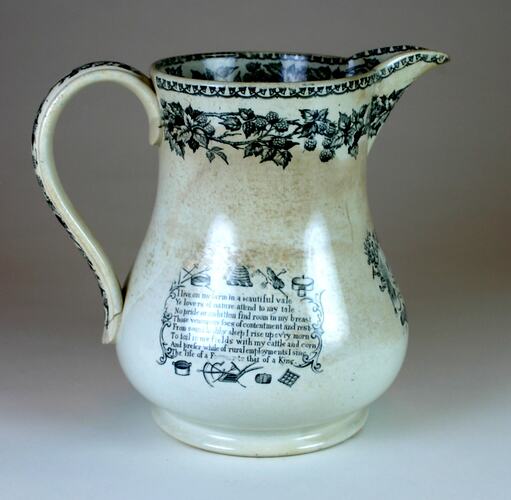Harvest jugs are pitchers thought to have been used to carry beer or mead to workers in the field at harvest time. A definitive period for which these jugs were made and used is difficult to identify, however, simple searches uncover jugs from about the 17th century to the 20th century. It is said that the traditions connected to harvest jugs continued into the 19th century (BBC Local History 2008; Cooper 2002; Spires 2009; Trustees of the British Museum).
Harvest jugs are usually associated with the North Devon region and slipware. North Devon slipware uses a red clay and white slip with a clear glaze. The decorative technique involves 'scratching through a layer of slip when almost dry to reveal the body beneath', called the sgraffito (originally from Italy) (Trustees of the British Museum). Staffordshire was also known for its slipware using the slip-trailing technique, also known as 'jewelled' (Brears 1971, p. 46), which involves covering the body of the dish with white or cream slip and then outlining designs with trailed red, dark brown or tan slip. (Cooper 2002, pp. 149-150)
The types of incised patterns used on North Devon harvest jugs include symbolic and popular motifs associated with harvest time. These were often alongside drinking rhymes, dates and the names of the makers. For example a late 18th Century earthenware jug is incised with a coat of arms, figures, flowers, plants and rhyme (Cooper 2002, p. 150). The Melbourne Museum jug has two poems surrounded by a border lined with various motifs associated with farms. They include sickles, wheat and beehives, and the rim of the jug is lined with decorative berry plant border.
As mentioned above, harvest jugs are thought to have played a role in the harvest time traditions. In relation to the North Devon region, the jugs could have originally been intended to carry cider to the field workers for refreshment during the harvest time. However, it is more likely that they were used to dispense cider at harvest suppers - at the end of the day's work. (Cooper 2002, p. 150; BBC Local History 2008).
In general, harvest time in the UK, as well as many other countries, has numerous associated customs and traditions. These include hymns of thanksgiving and other verse, corn dollies, harvest suppers, parades and fairs (Whitlock 1978, chapter 9). However the practice of many of these traditions would have depended upon the success of the harvest and future prospects, such as famine being the result of storms, rain and drought (Whitlock 1978, p. 127). This situation, of course, has not changed greatly over the years, since weather patterns continue to play a large role in the supply of food (but new technologies, practices and import/export contribute to greater consistency in supply for consumers).
References:
BBC Local History, Harvesting Memories, http://www.bbc.co.uk/print/devon/content/articles/2008/08/20/harvest_customs_feature.shtml. Accessed 17 July 2009.
Cooper, E. (2002). Ten Thousand Years of Pottery. The British Museum Press, London
Spires, R. Personal communication, May 26, 2009
Trustees of the British Museum, The British Museum Harvest Jug, http://www.britishmuseum.org/explore/highlights/highlight_objects/pe_mla/h/harvest_jug.aspx. Accessed 17 July 2009
Whitlock, R. (1978). A Calendar of Country Customs, B.T. Batsford Ltd, London
More Information
-
Keywords
-
Authors
-
Article types

